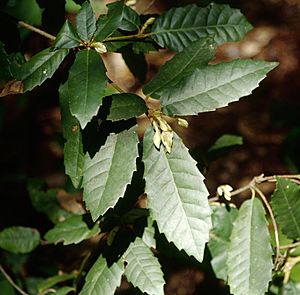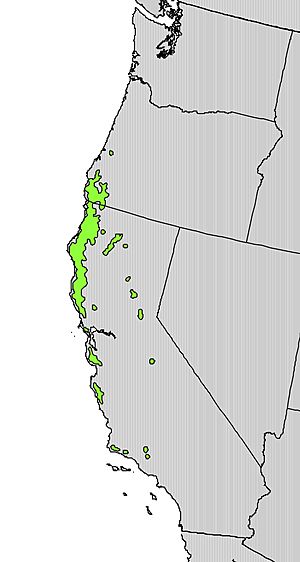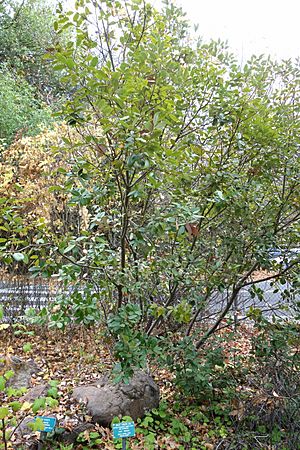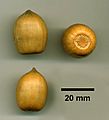Tanoak facts for kids
Quick facts for kids Tanoak |
|
|---|---|
 |
|
| Foliage | |
| Scientific classification | |
| Genus: |
Notholithocarpus
|
| Species: |
densiflorus
|
 |
|
| Notholithocarpus densiflorus range | |
| Synonyms | |
|
|
The tanoak (scientific name: Notholithocarpus densiflorus) is a type of tree found in the western United States. It is also known as the tanbark-oak. This tree is a broadleaf tree, meaning it has wide, flat leaves, and belongs to the Fagaceae family, which includes oaks.
You can find tanoaks growing in California, reaching as far south as the Transverse Ranges. They also grow north into southwest Oregon and east into the Sierra Nevada. These trees can grow very tall, sometimes up to 40 m (130 ft), but they are usually around 15–25 m (49–82 ft) tall. Their trunks can be quite wide, from 60–190 cm (24–75 in) across.
The tanoak was recently given a new scientific name, Notholithocarpus. Before this, it was called Lithocarpus densiflorus. Scientists changed its name because they found it is more closely related to the oak trees you might know (Quercus) than to the Asian stone oaks (Lithocarpus). This change shows how different trees can look similar even if they are not closely related. This is called convergent evolution.
Contents
What Does a Tanoak Tree Look Like?
Tanoak trees have special features that help you identify them. Their leaves grow one after another along the stem, which is called an "alternate" pattern.
Tanoak Leaves and Their Texture
The leaves are about 7–15 cm (2.8–5.9 in) long. They have edges that look like small teeth and feel hard and leathery. Tanoak leaves stay on the tree for three to four years before falling off. When they first appear, they are covered in fuzzy, orange-brown hairs on both sides. The hairs on the top surface soon fall off, but those underneath stay longer before eventually disappearing too.
Tanoak Acorns: Seeds of the Tree
The seed of the tanoak is an acorn. It is about 2–3 cm (0.79–1.18 in) long and 2 cm (0.79 in) wide. Tanoak acorns look very much like oak acorns. However, their outer shell is very hard and woody, more like a hazelnut.
The nut sits inside a cup that has short, spiny bumps on its outside surface. It takes about 18 months for the nut to fully grow and mature. Tanoak nuts usually grow in small groups on a single stem. The inside of the nut is very bitter. People cannot eat them without a special process called "leaching," which removes the bitterness. However, squirrels enjoy eating them just as they are.
Sudden Oak Death and Tanoaks
Tanoak trees are very vulnerable to a serious plant disease called "sudden oak death." This disease is caused by a type of water mold called Phytophthora ramorum. Many tanoak trees have died in areas where this disease is present.
Dwarf Tanoak: A Smaller Version
There is a smaller type of tanoak called "dwarf tanoak." Its scientific name is Notholithocarpus densiflorus var. echinoides.
These dwarf tanoaks are found in parts of interior California, like the northern Sierra Nevada, and in the Klamath Mountains up into southwest Oregon. They are much smaller than regular tanoaks, usually growing no taller than 3 m (9.8 ft). They often look more like shrubs than trees. Their leaves are also smaller, only about 4–7 cm (1.6–2.8 in) long. Sometimes, dwarf tanoaks grow on special types of soil called serpentine soils, where they also stay shrub-like.
How People Use Tanoak Trees
Tanoak trees have been useful to people for a long time, especially to Native American tribes.
Tanoak Acorns as Food
Some Native American tribes in California preferred tanoak nuts over many types of oak acorns. This is because tanoak nuts store very well. The Concow tribe called the nut hä’-hä in their Konkow language. The Hupa people used the acorns to make a type of flour. From this flour, they would make mush, bread, biscuits, pancakes, and cakes. They also roasted the acorns to eat them as a snack. Roasted tanoak seeds can even be used as a substitute for coffee.
Tanoak Bark for Tanning Leather
The name tanoak comes from its bark, which is rich in a substance called tannin. This type of bark, known as "tanbark," was used in the past for tanning leather. Tanning is a process that turns animal hides into durable leather.
However, by the early 1900s, people started using tanoak less for tanning. There were not enough large tanoak trees left to make it profitable. By the 1960s, most leather industries had switched to man-made tannins.
Other Uses of Tanoak
- A special type of mulch made from tanoak leaves can help keep away garden pests like grubs and slugs.
- The tannin from tanoak has also been used in medicine as an astringent, which helps to tighten body tissues.
- Sometimes, tanoak wood is used as lumber, but it is not commonly cut down for commercial use today.
The Biggest Tanoak Tree
The largest known tanoak tree is located on private land near the town of Ophir, Oregon. This amazing tree has a circumference of 26 feet (7.9 m) around its trunk. Its diameter at chest height is about 8.25 feet (2.51 m). It stands 121 feet (37 m) tall, and its branches spread out about 56 feet (17 m) wide.
Images for kids



